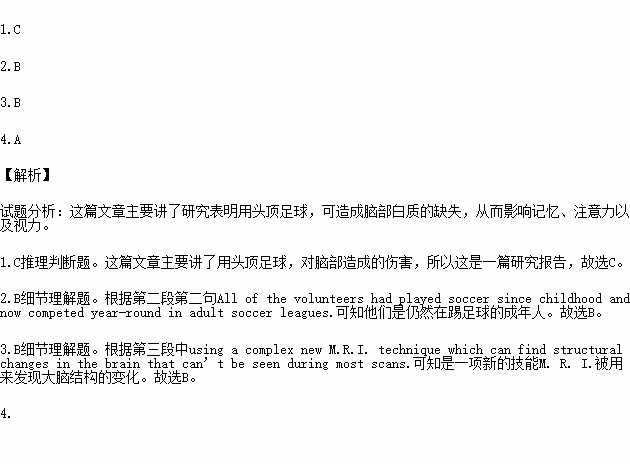题目内容
What happens inside the head of a soccer player who repeatedly heads a soccer ball? That question motivated a study of the brains of experienced players.
Researchers at the Albert Einstein College of Medicine in New York selected 34 adults, men and women. All of the volunteers had played soccer since childhood and now competed year-round in adult soccer leagues. Each filled out a detailed questionnaire developed especially for this study to determine how many times they had headed a soccer ball in the previous year, as well as whether they had experienced any known concussions (脑震荡) in the past.
Then the players completed computerized tests of their memory and other learning skills and had their brains scanned, using a complex new M.R.I. technique which can find structural changes in the brain that can’t be seen during most scans.
According to the data they presented, the researchers found that the players who had headed the ball more than about 1,100 times in the previous 12months showed significant loss of white matter in parts of their brains involved with memory, attention and the processing of visual information, compared with players who had headed the ball less.
This pattern of white matter loss is “similar to those seen in traumatic (外伤的) brain injury”, like that after a serious concussion, the researchers reported, even though only one of these players was reported to have ever experienced a concussion.
The players who had headed the ball about 1,100 times or more in the past year were also generally worse at recalling lists of words read to them, forgetting or fumbling the words far more often than players who had headed the ball less.
1. Where do you think the text comes from?
A. Medicine instructions. B. A text for doctors.
C. A research report. D. A sports advertisement.
2.What do we know about the volunteers?
A. They had serious injury on the head.
B. They were adults who still played soccer.
C. They were all researchers about soccer.
D. They all had children who played soccer.
3. What was used to find the structural changes in the brains?
A. Advanced computers.
B. A new technique M. R. I.
C. Special questionnaires.
D. Learning skills.
4. We can conclude that frequent heading may have .
A. a significant effect on one’s brain
B. little effect on one’s brain
C. nothing to do with the brain
D. improvement in one’s brain
 智慧小复习系列答案
智慧小复习系列答案
